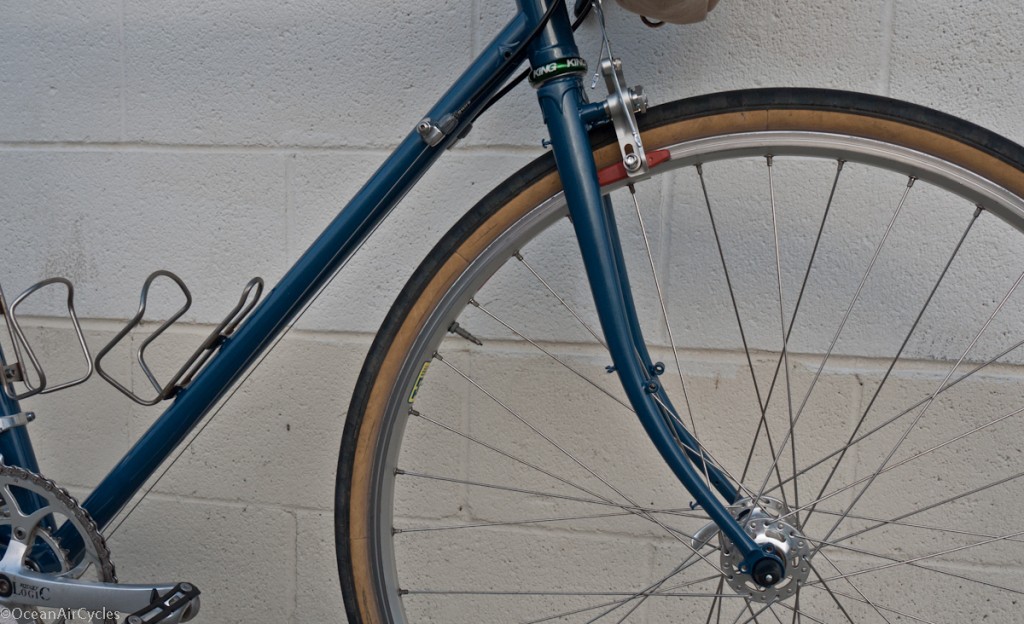 I have been able to put close to 100 miles or so on Rambler No.1, with lots of climbing and descending with varied loads. Everything with regard to handling has exceeded my expectations based on design and theory. With the long chain stays and low trail, it flies down hill like a missile. I was able to push the limits of my personal comfort zone at multiple points of the descent on the back side of Sulphur Mtn. For clarity it is a drop of 1400 feet over 4 miles, all twisty and some grades as high as 15%, needles to say there are some opportunities to push the limits. Cornering was precise and mindless, the bike was an extension of my body.
I have been able to put close to 100 miles or so on Rambler No.1, with lots of climbing and descending with varied loads. Everything with regard to handling has exceeded my expectations based on design and theory. With the long chain stays and low trail, it flies down hill like a missile. I was able to push the limits of my personal comfort zone at multiple points of the descent on the back side of Sulphur Mtn. For clarity it is a drop of 1400 feet over 4 miles, all twisty and some grades as high as 15%, needles to say there are some opportunities to push the limits. Cornering was precise and mindless, the bike was an extension of my body.
The Paul Racers pared to the Sram levers were the best brake set up I have ever used. The range of modulation is wide and precise, stopping power was easy to fine tune, and there was no fade or degradation at any point. The oddest part was that I could stop on a dime in the pavement, but it was hard if not impossible to initiate a skid, this is probably a good thing. The bonus was how easy they are to set up. I know people tend to squirm a the price of Paul brakes, but I will have a hard time going back to other brakes.
Shimmy is the unintended harmonic oscillation of the entire bike, and an issue that often comes up with this style of bike, particularly on the larger bikes with light tube sets. My first round build up of the two bikes was intended to give shimmy every chance it could to show up (within safe reason). The bike is what it is, 62cm with 9/6/9 tube set, I built it up with a King headset and my floppiest handlebar bag. loaded with random gear and a sloshing 1l bottle of water the shimmy never came. Only when riding with no hands and tapping the bar would it oscillate a few times and stop. Rambler No.3 had similar results, by my uncoached tester. It is a size 56 with 8/5/8 frame tubes and a Cane Creel 110 headset. At one point there was what he described as a little shake, he naturally loosened his grip and the shimmy stopped immediately, and did not return. While shimmy is and will remain a bit of a mystery as to its exact cause, I excited with the initial results of my testing.
I am pretty happy with the outcome of my design. It worked equally well for me at my experience level and a rider out for his first time on a true road bike. I have seen it debated that bikes with a low trail geometry require some sort of mystic skill level to handle well, and in my experience this is just not true. Saturday proved that again. The ride was double that of what my friend had ever done. He was able to maintain the pace of the group, handle the bike well, with day trip load, on a bike he had never ridden, not even that style of bike, and he had a blast. I my mind this is pretty solid proof that the bike worked as it should. Frosting on the cake is that he was not sore at all the next day, and I attribute that to a good fit and tubing spec. He was on the 56, with 8/5/8 DB tubes, and rider plus load was around 180lbs. He is naturally inclined to a high cadence, and even with long 175mm cranks there were no issues.
In the coming weeks I will be shifting the builds around a bit, to test different aspects of the bikes as well as confirm component figment for different brands, models etc. I will share detailed reports as I move through the process.
One area of detailing that keeps coming up is the provisions for light wiring. There are wire guides on the right fork leg to accommodate safe wire routing from the connection point of a dynamo hub to the top of the fork.
 There are also reinforced wire ports at the top of the down tube and the back of the down tube just above the bottom bracket. I feel this should allow plenty of options for wiring up head and tail lights to the dynamo hub should you choose that as a lighting option.
There are also reinforced wire ports at the top of the down tube and the back of the down tube just above the bottom bracket. I feel this should allow plenty of options for wiring up head and tail lights to the dynamo hub should you choose that as a lighting option.
Thanks for reading, and stay posted, the reports will be come more quickly.